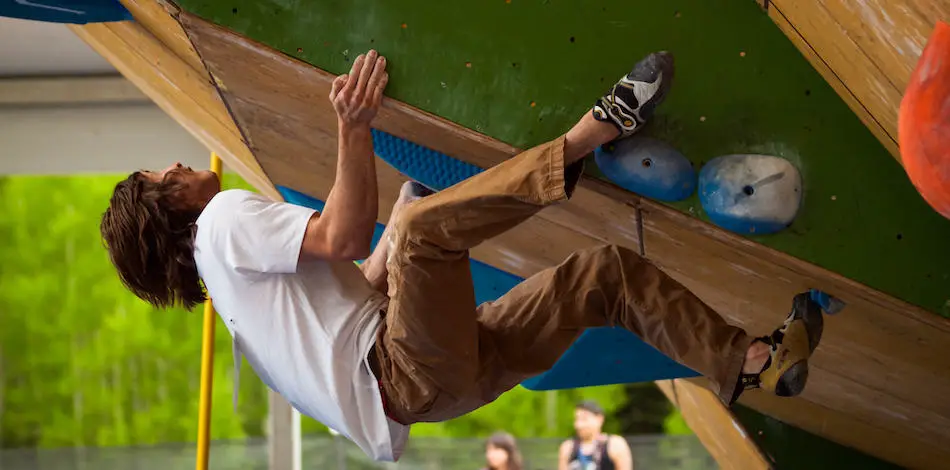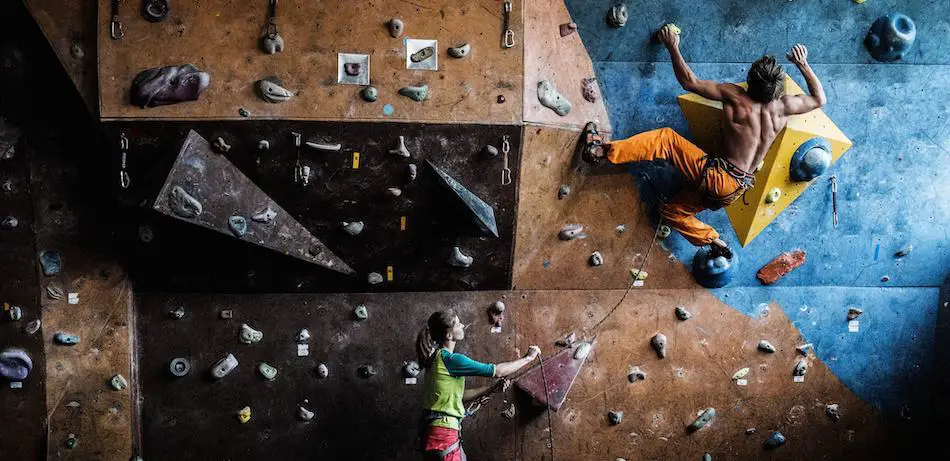
Trying new things is fun, but no one wants to get hurt while doing so. I’ve written the following guide to help you understand the risks of indoor bouldering.
So, is indoor bouldering dangerous? Indoor bouldering has a medium risk level for mild injuries, and a low risk level for serious injuries.
Compared to most other climbing-related activities, indoor bouldering is probably one of the safest ones out there. Your chances of taking a life-altering injury, or even breaking a bone, are fairly low. With that being said, though, it can still happen, and there are a slew of other, minor injuries that could happen to you while bouldering.
The Risk of Indoor Bouldering

The main risk of indoor bouldering comes down to this: you’re climbing up to twelve feet off the ground with no ropes or anything to hold you in place. This means that, if you slip off the wall, you’re high enough for the fall to hurt.
This is compounded by the fact that, while bouldering, you often have to put your body in awkward positions. This means that, when you do fall, your feet aren’t always below you, and you might land awkwardly.
Now, most of the time, this isn’t anything major. I’ve been bouldering for about five years now, and the worst I’ve had is my breath knocked out of me when I land awkwardly. For some other people, though, this could lead to a variety of different injuries.
Other than that, you risk injuring your body from what you do on the wall. Climbing is hard on your joints, and it involves contorting yourself in some pretty weird ways to make the moves work. This can put load on your muscles and ligaments, leading to muscular/tissue damage.
So, while you’re not going to fall to your death while bouldering, there is a moderate chance that you could end up with some type of injury that will take 2-4 weeks to heal, and a small chance that you could end up with a more serious injury.
Potential Indoor Bouldering Injuries

Here, I’ve listed some of the potential injuries that you could get while indoor bouldering, from least serious (and most likely to happen) to most serious (and least likely to happen).
Scrapes/bruises: Scrapes/bruises are almost a given in bouldering. The climbing wall and holds are made of a fairly abrasive material, and if you scrape against it, you can take off a couple of layers of skin. Thankfully, these tend to heal within a week.
Serious scraping: Also known as a cheese grater, this is when a large part of your body slides down a section of the bouldering wall. This is extremely painful, and you should try to avoid it, but it’s not serious; it should heal up just fine in a couple of weeks.
Ankle injuries: Any time you’re falling from a decent height, you risk landing wrong and injuring one of your ankles. Once of my friends did this fairly recently, and she was out for a couple of weeks. The hard thing with ankle injuries is that there’s no predicting how serious they’re going to be; if you land and roll one badly, it might not heal up for six months.
Ligament/Tendon tears: These are injuries that you’ll get from climbing, not necessarily from falling. The most common tendons to injure are those in either your fingers or your shoulders, two areas that often get loaded in weird ways while climbing. Even with proper care and physio, a bad tendon injury can put you out for up to a year, so do your best to avoid these.
Neck Injuries: Probably the worst indoor bouldering injury that you could have is ones to your neck. If you manage to twist the wrong way while falling, you could land head-first. The soft mats will likely prevent you from concussing yourself, but they won’t stop your bodyweight from transferring to your neck, which could do some serious damage.
Stay Safe Indoor Bouldering
So, now that we know about the injuries you can get while indoor bouldering, how do you avoid them? If you’re a beginner, there are three main things that I can recommend:
Learn How to Fall
The first thing you should do when you walk up to a bouldering wall is learn how to fall. The proper form is to land feet first with soft knees and your arms tucked in close to your chest. You want to roll as you land, transferring the weight onto your butt and keeping your chin tucked.
Doing it this way distributes the force of the fall and prevents any particular body part from getting bent out of shape. It’s not always easy to get into perfect falling form, but you should always keep the core idea of trying to go feet-first and keeping your arms/chin tucked in.
Warm Up
Warming up ensures that your muscles, ligaments, and tendons have the proper amount of blood flow in them. It loosens you up and helps to prevent injuries.
A good warmup includes:
- 3 minutes cardio: Nothing crazy, but a good way to get your blood pumping
- 5 minutes active stretch: Pay special attention to your hips, shoulders, and forearms
- 10 minutes easy climbing: you should climb at a level that doesn’t even come close to challenging you, but allows you to warm up your forearms and fingers
- 20 minutes, gradual increase: over the next 20 minutes, slowly build up the difficulty of your climbs before you start really going at it.
Know Your Limit
Probably the best way to avoid getting injured while climbing is to not push yourself too hard.
Now, obviously, climbing is all about challenging yourself and seeing just how far you can go, but climbing past your limit is a sure fire way to get injured.
By keeping it a little more conservative and never asking too much of your body, you’ll avoid getting saddled with a injury that could put you out for months.
Indoor Bouldering vs. Outdoor Bouldering

Indoor bouldering is significantly less risk than its outdoor counterpart. While going outdoors seems like a natural progression from the indoor world, it’s almost akin to an entirely different sport.
Probably the biggest difference between indoor and outdoor climbing is the availability of padding to land on. Indoors, you’re almost always climbing on massive, 1.5-foot thick pieces of composite foam to catch you if you fall.
I’ve had some pretty awkward landings in the past, and I’ve never hurt myself because of how good the cushioning is.
Outdoor, though, you need to carry in your own padding (called crash pads), which are much thinner and less protective that what you have inside. This means that any fall is automatically worse, and your chances of breaking/spraining something go up exponentially.
You also have to learn where to place the padding strategically to protect the most dangerous sections of the climb, which takes some practice (and, at the end of the day, some guesswork).
Because of that, the risk of both mild and serious injury while outdoor bouldering is significantly higher than when indoor bouldering.
Indoor Bouldering vs. Indoor Climbing

Indoor climbing is broken into two categories:
Top Rope
Top rope climbing indoors is probably the safest form of climbing you can do. There’s a rope ready to catch you whenever you fall, so you don’t have to worry about and of the sprained ankles or neck injuries.
The only real problem when you’re top roping is that you have to be confident that your knots are tied correctly and that your belayer knows what they’re doing, or else you risk getting dropped. This is pretty easy to do with the right coaching and practice, though
Lead
Lead climbing has a higher risk of minor injury, but a lower risk than serious injury than indoor bouldering does. Minor injuries can come in the form of a fall that swings you aggressively into the wall, leading to bruising and perhaps a concussion.
You’re still roped in, though, so you don’t have to worry about the neck damage that could happen with a serious bouldering fall.
